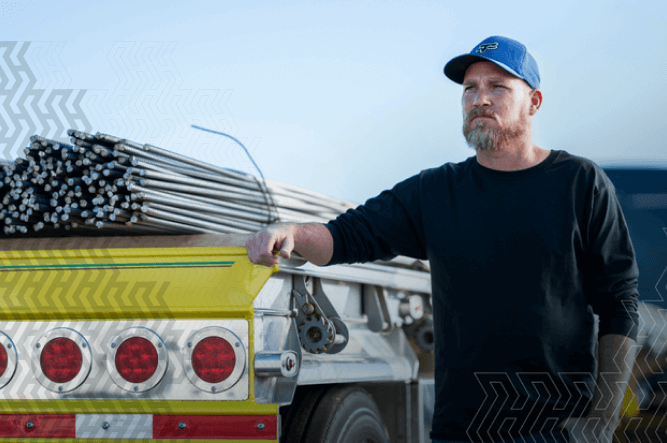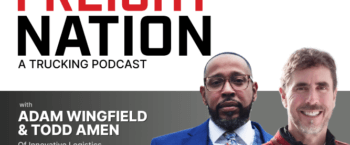Flatbed Trucking Explained: How it Works, Rates, and More

What are you waiting for?
Make more money starting now.
Find your next load
Make more money starting now.
Flatbed trucking is a necessity for the movement of goods and materials and continues to be widely used due to its versatility and adaptability. Flatbeds transport oversized, irregularly shaped, and bulky cargo that traditional enclosed trailers cannot accommodate and make up a significant portion of commercial trucking.
Flatbed trucks play a crucial role across various businesses and industries, which translates to high demand for flatbed truck drivers. If you’re considering a career in trucking, you might be wondering if flatbed trucking is the right fit for you. And if it is, where can you find flatbed trucking jobs?
Learn more about how flatbed trucking works and the steps you can take to become a flatbed truck driver.
What is flatbed trucking?
Flatbed trucking involves using a truck that has no walls or roofs, leaving the trailers open, unlike a traditional box trailer. Flatbed trailers consist of a wooden platform supported by a strong aluminum frame. While the decks are flat, some flatbed trailers also carry drop decks.
Flatbed trailers are 48 to 53 feet long with a width of 102 inches, a deck height of 60 inches, and a weight capacity of up to 48,000 pounds. They can also include step-deck or removable gooseneck (RGN) trailer types.
Because they are open, flatbed trailers offer a lot of logistics options, especially when it comes to heavy or oversized cargo.
Common uses of flatbed trucking
Flatbed trucks are known for their versatility. Because of how they are structured, flatbed truck trailers can transport taller and heavier items.
Specifically, flatbeds are ideal for oversized cargo and freight that enclosed vans can’t easily carry. You’ll often see flatbed trucks hauling long pipes and highway barriers. Additional cargo that flatbed trucks can haul includes:
- Lumber
- Steel coils
- Mobile homes
- Bailed tires
- Wind turbines
- Military machinery
- Scrap metal
- Tow trucks
Flatbed transport is also highly useful for moving shipping freight containers. The trucks carry the containers from inland ports or factories to seaports, where they’re loaded onto ships. Flatbed trailers can haul super sacks, too. These industrial fabric bags can hold up to 2,000 pounds of dry products, such as sand, fertilizer, or seeds.
Key facets of flatbed trucking
Although flatbeds are versatile, drivers need to understand four factors to ensure a successful and safe trip: loading, securing, tarping, and maneuvering.
Loading
Most of the time, forklifts or cranes load heavy freight onto flatbeds. But it’s the driver’s responsibility to make sure the load is balanced correctly over the axles. Unbalanced cargo can cause serious handling problems and potential accidents and injuries.
Securing
Flatbed truck drivers are responsible for keeping the loads steady and secure throughout the trip. The U.S. Department of Transportation (DOT) has strict rules about securement devices. Usually, drivers secure cargo using webbed nylon straps tightened by a winch. If you’re transporting heavier cargo, such as steel pipes or large machinery, use thick steel chains to keep the cargo stable.
Tarping
Because flatbed trailers don’t have walls or a roof, they — and the cargo they carry — are exposed to the elements. Tarping protects your goods during transport. But there’s more to this than simply throwing a covering over the cargo. Tarps can weigh up to 80 pounds, so you may need a forklift to put them in place.
Maneuvering
Given what they carry and their length, flatbed trucks can be trickier to drive than dry vans. You need skills to maneuver an extra-wide or extra-long truck through traffic or inclement weather. Sharp curves can also cause cargo to shift, creating an unbalanced load that makes maneuvering even harder.
Flatbed trucking rates
How much are typical flatbed trucking rates? Depending on the region, type of freight, and market conditions, rates can range between $2.27 to $2.66 per mile.
Higher per-mile rates mean higher salaries. As a flatbed truck driver, you could earn up to $15,000 more per year than a dry van driver.
Advantages of flatbed trucking
Higher pay is one clear advantage of driving a flatbed truck. But there are some other perks, as well.
Greater demand
The trucking industry continues to suffer from a shortage of drivers, especially in flatbed trucking. Because of that shortage, flatbed truck drivers have a high degree of job security.
More travel potential
Flatbed truck drivers may have more opportunities for long-distance travel, based on flatbed trucker shortages and the fact that shippers may be moving large cargo between seaports and inland destinations.
Less waiting time
Forklifts or cranes are usually required for loading or unloading a flatbed. That makes the flatbed shipping process much faster than the manual cargo-moving process most dry van drivers experience. Flatbed truck drivers spend less time waiting at pickup and dropoff locations, and they usually make fewer stops per load. That means that a flatbed truck driver may have more time off between loads.
Easier maintenance
Dry vans or walled-in truck beds accumulate plenty of dirt and debris that can be tough to remove. But the open deck of a flatbed truck makes upkeep much easier — and there are no roofs or sidewalls that can be scratched or dented.
Disadvantages of flatbed trucking
While there are plenty of advantages to being a flatbed trucker, there are also downsides you should know.
More danger
Flatbed truck drivers carry larger, heavier freight, which must be properly secured per DOT guidelines. The process of securing cargo on a flatbed truck — sometimes climbing over and around it while on a highway shoulder — raises the risk of on-the-job injury.
Stricter regulations
Because of the inherent risks, the DOT and other agencies enforce stringent laws and regulations for flatbed trucking. A flatbed truck driver may also need special permits for transporting large loads and have to follow specific routes that can accommodate the additional weight of a load. Failure to follow regulations, secure the right permits, or follow designated routes can result in fines and other penalties.
Higher skill requirements
Driving a flatbed truck sometimes requires specialized driving and hauling skills, as well as load securement training. In addition to being able to operate your flatbed truck, you also need to be able to meet the physical demands of maneuvering and securing oversized loads.
Risk of weather-related delays
With cargo partially or fully exposed to the elements, weather-related delays are sometimes inevitable in flatbed trucking. That means drivers may be on the road longer than planned or miss their scheduled delivery time.
Find, compare, and book high-paying flatbed loads.
Are you ready to get into business as a flatbed truck driver? You’re in luck! You can find high-quality loads for flatbed trailers on the Truckstop Load Board. This invaluable tool makes searching for loads and booking freight a breeze for flatbed truckers. Save time, and earn more money.
Search.
The Truckstop Load Board lets you perform unlimited searches to find the right job from companies in need of a flatbed truck. You can use the Load Board to plan advance trips, find higher-value loads, and do multi-trip searches.
Compare.
Our advanced technology lets you compare multiple loads all on one screen so you can zero in fast to find the flatbed trucking job that’s right for you.
Analyze rates.
The Truckstop Load Board offers same-day rate data and industry-leading metrics. Find the best equipment rates, calculate fuel surcharges, and see supply and demand at origin and destination locations.
Book instantly.
Once you’ve found your ideal load, rate, and lanes, the Truckstop Book It Now feature lets you book loads instantly with trusted brokers. Saving precious time booking and scheduling gets you on the road faster.

Find out how our platform gives you the visibility you need to get more done.
Get helpful content delivered to your inbox.
Schedule a demo.
Find out how our platform gives you the visibility you need to get more done.





